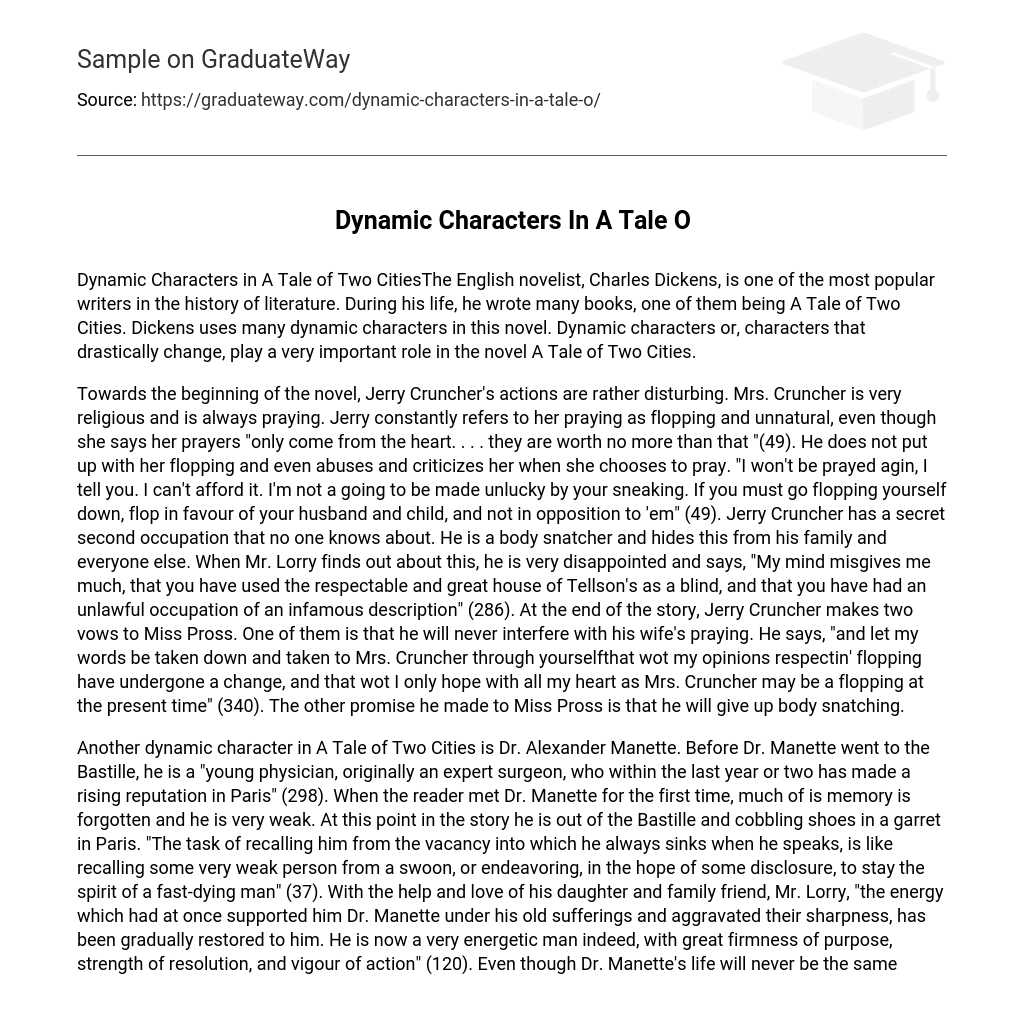Charles Dickens, a highly regarded English novelist, is renowned and praised for his literary works. A Tale of Two Cities stands out as one of his most famous books, showcasing Dickens’ adeptness in introducing a varied array of dynamic characters who experience substantial changes. These dynamic characters hold immense importance within the narrative of A Tale of Two Cities.
Initially, Jerry Cruncher’s behavior in the novel is disconcerting. Despite Mrs. Cruncher’s devoted religious practices of constant prayer, Jerry dismissively refers to it as “flopping” and considers it unnatural. Mrs. Cruncher affirms that her prayers are genuine and heartfelt, asserting that they hold no greater significance than that (49). However, Jerry refuses to tolerate her praying and even mistreats and criticizes her for choosing to engage in it. He declares his unwillingness to allow himself to be prayed against, believing it would bring him misfortune. Instead, he encourages his wife to pray in support of him and their child rather than opposing them (49).
Jerry Cruncher, unknown to his family and others, has a covert and illicit second job as a body snatcher. Mr. Lorry, upon discovering this, expresses his profound disappointment, suspecting that Cruncher has utilized the reputable Tellson’s establishment as a facade for his dishonorable and illegal activities (286).
Jerry Cruncher makes two promises to Miss Pross at the end of the story. Firstly, he vows to never interfere with his wife’s prayers. He specifically asks Miss Pross to convey this message to Mrs. Cruncher, expressing that his opinions regarding “flopping” have changed and he hopes she is currently engaged in praying. Secondly, Jerry promises to cease his activities of body snatching.
In A Tale of Two Cities, Dr. Alexander Manette also experiences significant transformations. Prior to being imprisoned in the Bastille, he was a renowned surgeon who swiftly rose to prominence in Paris (298). Nevertheless, upon his initial introduction in the narrative, he is depicted as feeble and suffering from substantial memory loss. At this point in the tale, Dr. Manette has been freed from the Bastille and currently occupies a garret in Paris where he works as a shoemaker.
According to the text, waking him up from his unconscious state when he speaks is as difficult as reviving a faint person or trying to prolong the life of a dying man in hopes of gaining some revelation (37). However, with the assistance and affection from his daughter and family friend Mr. Lorry, Dr. Manette’s energy that previously exacerbated his sufferings has slowly been restored. As a result, he has become an incredibly strong and determined individual with a clear sense of purpose and vigor (120).
Dr. Manette, despite his irreversible transformation from his time in the Bastille, is able to regain his memory and openly discuss his past experiences. In the novel, both Dr. Manette and Sydney Carton encounter numerous challenges that significantly shape their characters. At first, Carton views himself as a downtrodden servant who lacks empathy for others and disregards their opinions of him (76).
Carton is a deeply unhappy person who believes he is trapped in a hopeless situation. He drinks excessively and sees himself as little more than a sidekick to C.J. Stryver. However, his love for Lucie Manette is the one positive aspect of his life. When he learns that Lucie is marrying Charles Darnay, Carton confesses his true feelings to her, promising that he would do anything to protect the life she loves. He tells Lucie, “Think now and then that there is a man Carton who will give his life, to keep a life you love beside you” (140-141).
This conversation with Lucie could be seen as the pivotal moment in Carton’s life, as he begins to show care for himself and others. Even Lucie’s perception of Carton changes. When Charles Darnay speaks unfavorably of Carton, Lucie takes offense. She advises her husband to always be generous toward Carton and to be forgiving of his faults when he is not present. Lucie wants him to recognize that Carton has a rarely revealed heart and carries deep wounds. She tells her husband, “My dear, I have seen it bleeding.” In the end of the story, Sydney Carton fulfills his promise to Lucie by sacrificing his life for her husband, Charles Darnay.
Before approaching the guillotine, Carton’s final thoughts were, “It is a far, far better thing that I do, than I have ever done; it is a far, far better rest that I go than I have ever known” (353). This quote emphasizes that he considers his act to be the most significant and unexpected good deed of his life. Despite never believing he had any value or purpose, the sacrifice Carton made profoundly impacts a family’s future.
In Charles Dickens’ novel A Tale of Two Cities, dynamic characters play significant roles. Jerry Cruncher relinquishes body snatching and opts to support Mrs. Cruncher’s endeavors. Sydney Carton becomes more self-reliant and makes the ultimate sacrifice for Darnay, demonstrating personal transformation. Dr. Alexander Manette recovers his memory, enabling him to lead a joyful and affectionate existence.





